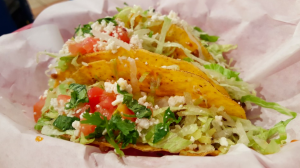Let’s face it: food pricing is part science and part art. It’s a blend of what you need to price your product at vs. what shoppers will actually pay at the food truck or restaurant. And believe me, you won’t solve this overnight. Feeling confident about your pricing takes practice!
If you’re in the middle of trying to figure out pricing strategy for your food products or menu, there are several great tips here:

How much would you charge for tacos?
Myth #1: I don’t need to know how much my product costs.
Well, yes you do. It’s integral to every decision you’ll make as a business owner: your margins, retail price, and ultimately your success. Often times, entrepreneurs who have no idea what their product costs are end up practically out of money and wonder how other people do it. The answer? They have their financials and product costs wrapped around their finger. Don’t know how to calculate your food product cost? Take the time to learn this important step.
Myth #2: I’ll never get a distributor so they don’t need to be in my calculations.
What if you’re wrong? You may not have a distributor now, but what about in a year or two? What will you do when the distributor takes 30 points (aka 30%) right out of your margin? Not to mention promotional fees and other distributor costs. Here’s an example: If you have a 50% margin (make your product for $4 and sell for $8), a distributor will knock you right down to 20% – not a survivable margin. If you’re starting a food business, factor in a distributor from day one. It’s critical to your growth.
Myth #3: I’ll keep my prices low so people can afford my products.
Another example for you: Make a product for $2 and sell it for $3. That spells disaster. You wouldn’t be able to make enough money to make more product. If you can’t make more product, then you’re out of business.
Just because you think you’ll sell more product at a cheaper price, it means nothing if you don’t make enough money to stay in the game. Price your products so you’re in it for the long-haul. You can always drop your price (or increase it!).
Myth #4: I’ll sell everything I make for the same price so it’s easier to keep track of how much I make.
I’ve been hearing from a lot of you that you’d like to sell multiple products (jam, salsa, chocolate bars, etc.) Keep in mind that different products have different costs. If you sell everything for $5, chances are you may not be making money. Again, price products so you can make money.
Myth #5: The retailer will put my product on sale so it sells.
Retailers don’t put your products on sale. You (or your distributor/broker) are in charge of putting your products on sale. You schedule the promotions, the mark-downs, the dates, and more. Keep in mind that putting your product on sale means that even more percentage points are taken from your margin.
BUT, promotions also mean you sell more product. In theory, you’d make your money up on the volume generated from the sale period. I’ve got a great course on promotions if you’re interested.
Myth #6: If I sell a pallet of product, I should give the buyer a deep discount.
Remember myth #3? This doesn’t make sense either. You have healthy margins you need to meet. If you feel pressured by the buyer to give you better pricing, maybe come down close to your distributor pricing, but do not go below it. On volume pricing, I’d recommend not dipping below 35% margin.
Myth #7: My labor is free because I make the product.
This one kills me. I see it all the time with small businesses and farmers market vendors. They spend all day, all weekend, to make product. And then they think they have great margins because they aren’t counting the time and money they’re investing to make product. Taking time to make your product takes you away from selling your product, so it’s best you get “paid” for your time.
If it takes you an hour to make 48 muffins and you “charge” $15/hr, you really have a labor cost of $0.31/muffin. That means, if you incorporated that money into your product cost, it would be an extra $1.24 on the shelf. That could be an expensive muffin! Please, please, calculate your labor so you know the real cost of producing your products. This is especially important part of the overall costs on a food truck or in a restaurant.
Have you made any mistakes from pricing your food products? Let me know in the comments below!

Leave A Comment